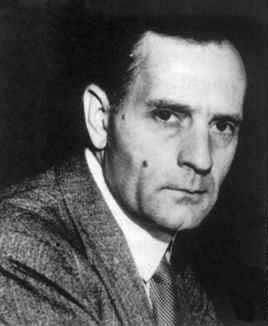


 تاريخ الرياضيات
تاريخ الرياضيات
 الرياضيات في الحضارات المختلفة
الرياضيات في الحضارات المختلفة 
 الرياضيات المتقطعة
الرياضيات المتقطعة
 الجبر
الجبر
 الهندسة
الهندسة 
 المعادلات التفاضلية و التكاملية
المعادلات التفاضلية و التكاملية 
 التحليل
التحليل
 علماء الرياضيات
علماء الرياضيات |
Read More
Date: 5-6-2017
Date: 7-6-2017
Date: 13-6-2017
|
Born: 20 November 1889 in Marshfield, Missouri, USA
Died: 28 September 1953 in San Marino, California, USA

Edwin Hubble was a man who changed our view of the Universe. In 1929 he showed that galaxies are moving away from us with a speed proportional to their distance. The explanation is simple, but revolutionary: the Universe is expanding.
Hubble was born in Missouri in 1889. His family moved to Chicago in 1898, where at High School he was a promising, though not exceptional, pupil. He was more remarkable for his athletic ability, breaking the Illinois State high jump record. At university too he was an accomplished sportsman playing for theUniversity of Chicago basketball team. He won a Rhodes scholarship to Oxford where he studied law. It was only some time after he returned to the US that he decided his future lay in astronomy.
In the early 1920s Hubble played a key role in establishing just what galaxies are. It was known that some spiral nebulae (fuzzy clouds of light on the night sky) contained individual stars, but there was no consensus as to whether these were relatively small collections of stars within our own galaxy, the 'Milky Way' that stretches right across the sky, or whether these could be separate galaxies, or 'island universes', as big as our own galaxy but much further away. In 1924 Hubble measured the distance to the Andromeda nebula, a faint patch of light with about the same apparent diameter as the moon, and showed it was about a hundred thousand times as far away as the nearest stars. It had to be a separate galaxy, comparable in size our own Milky Way but much further away.
Hubble was able to measure the distances to only a handful of other galaxies, but he realised that as a rough guide he could take their apparent brightness as an indication of their distance. The speed with which a galaxy was moving toward or away from us was relatively easy to measure due to the Doppler shift of their light. Just as a sound of a racing car becomes lower as it speeds away from us, so the light from a galaxy becomes redder. Though our ears can hear the change of pitch of the racing car engine our eyes cannot detect the tiny red-shift of the light, but with a sensitive spectrograph Hubble could determine the redshift of light from distant galaxies.
The observational data available to Hubble by 1929 was sketchy, but whether guided by inspired instinct or outrageous good fortune, he correctly divined a straight line fit between the data points showing the redshift was proportional to the distance. Since then much improved data has shown the conclusion to be a sound one. Galaxies are receding from us, and one another, as the Universe expands. Within General Relativity, the theory of gravity proposed by Albert Einstein in 1915, the inescapable conclusion was that all the galaxies, and the whole Universe, had originated in a Big Bang, thousands of millions of years in the past. And so the modern science of cosmology was born.
Hubble made his great discoveries on the best telescope in the world at that time - the 100-inch telescope on Mount Wilson in southern California. Today his name carried by the best telescope we have, not on Earth, but a satellite observatory orbiting our planet. The Hubble Space Telescope is continuing the work begun by Hubble himself to map our Universe, and producing the most remarkable images of distant galaxies ever seen, many of which are available via the World Wide Web.
Books:



|
|
|
|
التوتر والسرطان.. علماء يحذرون من "صلة خطيرة"
|
|
|
|
|
|
|
مرآة السيارة: مدى دقة عكسها للصورة الصحيحة
|
|
|
|
|
|
|
نحو شراكة وطنية متكاملة.. الأمين العام للعتبة الحسينية يبحث مع وكيل وزارة الخارجية آفاق التعاون المؤسسي
|
|
|